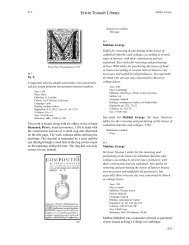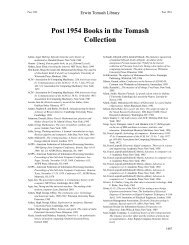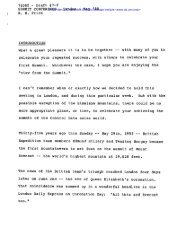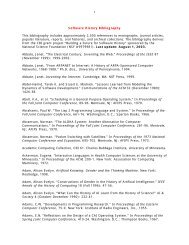B chapter.indd - Charles Babbage Institute - University of Minnesota
B chapter.indd - Charles Babbage Institute - University of Minnesota
B chapter.indd - Charles Babbage Institute - University of Minnesota
You also want an ePaper? Increase the reach of your titles
YUMPU automatically turns print PDFs into web optimized ePapers that Google loves.
Year: 1564<br />
Place: Venice<br />
Publisher: Francesco di Franceschi<br />
Edition: 1st<br />
Language: Italian<br />
Figures: two double-page figures plus many woodcuts in the<br />
text<br />
Binding: contemporary vellum; with ties renewed<br />
Pagination: ff. [4], 48, 45–48, 49–141, [3]<br />
Collation: A4A–M4M4N–2N4 Cosimo Bartoli, B 109<br />
(Signature M repeated)<br />
Size: 226x170 mm<br />
Reference: Ricdi BMI I, p. 90<br />
Cosimo Bartoli was an exponent <strong>of</strong> using Italian,<br />
rather than Latin, for technical writing. In this book<br />
on surveying, he essentially translates the earlier Latin<br />
works <strong>of</strong> others (e.g., Oronce Fine, Alberti, Dürer and<br />
Gemma Frisius), making them available to the average<br />
literate Italian. The border <strong>of</strong> the title page is copied from<br />
Erwin Tomash Library<br />
Bartoli, Cosimo Bartoli, Cosimo<br />
B 109<br />
Quadrant, B 109<br />
Jacob’s staff, B 109<br />
Circumferentor, B 109<br />
his 1550 translation <strong>of</strong> Alberti’s De Re Aedificatoria (not<br />
in this collection), but his portrait was done specifically<br />
for this one. The title page, portrait and all the woodcut<br />
illustrations were used for subsequent editions <strong>of</strong> this<br />
work.<br />
This well-known volume actually comprises six books,<br />
covering everything a surveyor should know about a<br />
variety <strong>of</strong> instruments. It begins with simple illustrations<br />
<strong>of</strong> the use <strong>of</strong> Jacob’s Staff and a quadrant with shadow<br />
scales and progresses to the use <strong>of</strong> more complex<br />
instruments in a wide variety <strong>of</strong> applications. The second<br />
and third books cover practical applications <strong>of</strong> plane<br />
and solid geometry such as finding areas and volumes<br />
<strong>of</strong> irregular figures. Book 4 deals with cartography<br />
and is notable for a description <strong>of</strong> the use <strong>of</strong> the device<br />
called a circumferentor—an instrument combining a<br />
117







